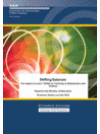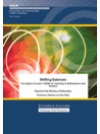This evaluation was carried out by the Education Review Office under contract to the Ministry of Education in 2004.
The School Staffing Review Group reported to the Government in February 2001. The recommendations of the Review Group targeted two key goals: to improve the capacity of schools to deliver quality education; and to alleviate problems associated with teacher workload. The Government has responded to these recommendations by developing the School Staffing Improvement Plan, known as School Staffing Improvements. By 2004, approximately 2,090 additional teaching staff, of an intended total of 3,700, had been made available to schools as part of this plan.
The Ministry of Education has recognised that there are significant difficulties in evaluating the impact of the additional teacher resource on student outcomes. The lack of parameters around the use of the resource, and the wide range of options open to schools, create a major challenge in evaluation. These issues led to a phased approach being proposed, with phase one providing indicators for a more detailed second phase of evaluation.
A theory-based approach (see methodology) was used for this evaluation in order to address the challenge of evaluating across multiple contexts.
This study is the first stage of a proposed evaluation to measure the impact of School Staffing Improvements on student outcomes. In particular, this stage of the evaluation has focused on the decisions schools make about using their additional teaching staff entitlement, and the way in which they are measuring the effectiveness of the way in which the entitlement has been used. One hundred and ten schools, across all school types, were included in the sample for this evaluation.


